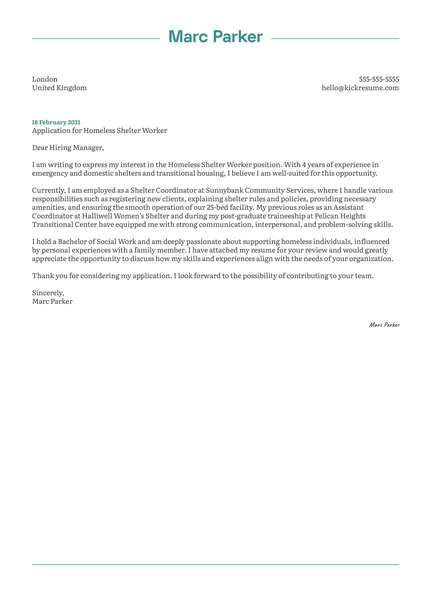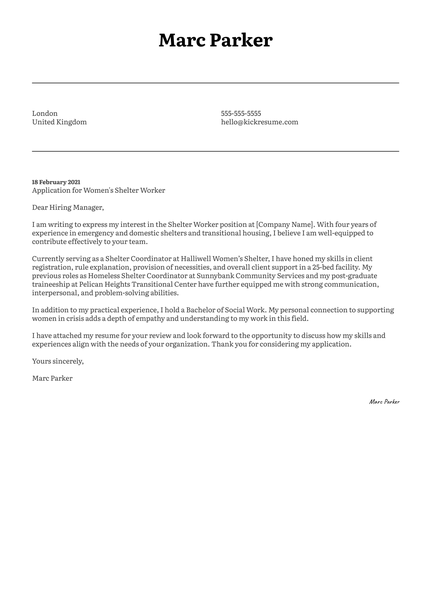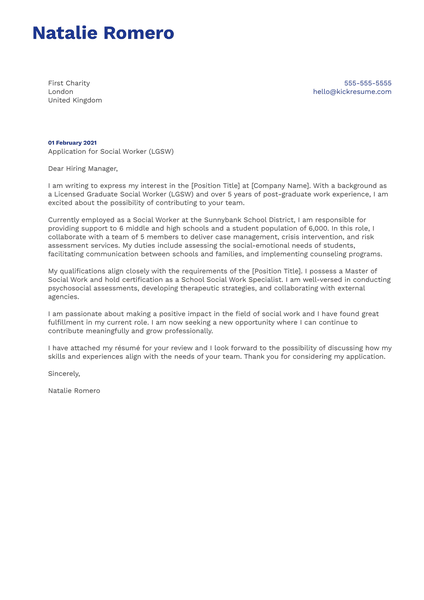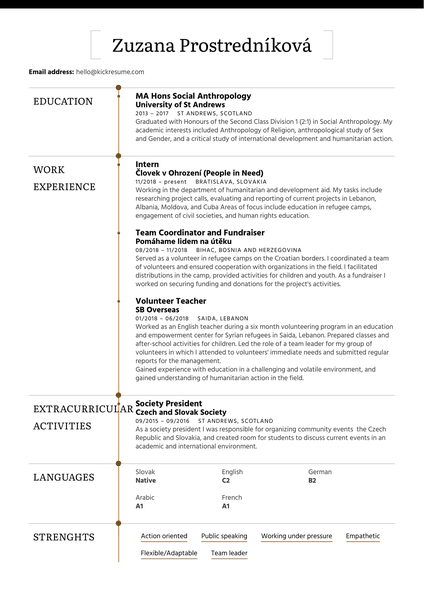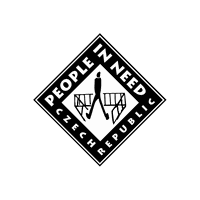Ready to make an impact as a refugee volunteer? Don't just dust off your resume, craft a compelling refugee volunteer cover letter, too. It's the perfect recipe to demonstrate your professionalism, compassion, and commitment to the cause.
And don't worry, we've got your back — with handy tips, real-world examples, and compelling templates that will put your cover letter head and shoulders above the rest.
Continue reading to learn how to:
- Give your refugee volunteer cover letter structure and visual organization
- Tailor your cover letter for a specific position as a refugee volunteer
- Write a strong introduction that conveys your top qualifications
- Highlight your best and most relevant skills and accomplishments
- Conclude your refugee cover letter persuasively
- Find useful job search resources for refugee volunteers
1. Give your refugee volunteer cover letter structure and visual organization
When applying to an essential position such as a refugee volunteer, it is crucial to make sure the volunteer organizer can easily navigate and make sense of your cover letter.
To do this, you must give your cover letter visual structure and organization using a cover letter header and cover letter headline.
Starting with your header, this element must include all the necessary identifying information, such as:
- Your name and professional title
- Your professional contact information
- The name of the volunteer organization you are applying to
Additionally, your header should be left-aligned in the top left corner of the document to make it as visually appealing as possible.
Here is an example of a well-formatted refugee volunteer cover letter header
Owen Kramer, Refugee Volunteer
(123) 456-7890 | owenkramer@email.com | linkedin.com/in/owen-kramer
To: American Red Cross
Refugee Volunteers Department
1234 Street Address
Washington, D.C. 20001
Once you have created your header, you must now write a compelling headline that lets the reader know you are not only passionate about this position but have the necessary skills for it.
To do so, make sure your header includes:
- A keyword that relates to the position
- A number or trigger word that grabs the reader’s attention
- An adjective and/or verb that compliments your skills and professionalism
- A promise statement that lets the reader know this letter is exclusively for them
Here is an example of an effective headline from a refugee volunteer cover letter
The 3 Key Skills that Make Me a Passionate Refugee Volunteer & These Skills Can Support Your Team
Trigger Word/Number: 3 Skills
Keyword: Refugee Volunteer
Adjective/Verb: Passionate, Support
Promise: Your Team
2. Tailor your cover letter for a specific position as a refugee volunteer
With your header and headline in place, you must now ensure that the rest of the text found in your cover letter is highly specific to the volunteer organization as well.
This is accomplished by researching the organization thoroughly before beginning the writing process. Important details to look for include what types of refugees the organization works with, what types of duties volunteers are responsible for, and what the organization’s overall goals and values are.
Additionally, you should look up who at the organization is responsible for onboarding new volunteers and use this information to create a personalized greeting.
This type of greeting will address this specific person by name and let them know right away that you have taken the time and effort to complete research before applying for the position.
Here are 3 examples of personalized greetings from a refugee volunteer cover letter
- Dear Head Volunteer Jane Miller,
- Dear Refugee Volunteer Organizer Jane Miller,
- Dear Mrs. Jane Miller,
3. Write a strong introduction that conveys your top refugee volunteer qualifications
After completing your header and headline, as well as the research you will use to make your letter as personal to the reader as possible, you can begin writing your introduction.
The introductory paragraph is essential, as it is often the deciding factor in whether or not the reader considers you a worthwhile candidate for the position.
To impress volunteer organizers in your cover letter introduction, make sure to include:
- A concise summary of your professional qualifications and experience
- A statement on why you have chosen to apply and/or why you believe you are the ideal candidate
- A mutual acquaintance — a mutual acquaintance can be any professional acquaintance that has a relationship with both you and the employer, including former bosses or mentors. If you do not have a mutual acquaintance, you can build your professional network using a professional social platform such as LinkedIn.
Here is an example of a strong introduction from a refugee volunteer cover letter
Dear Head Volunteer Jane Miller,
As a long-time and passionate refugee volunteer, I have more than 7 years of experience working with refugees from Latin and South America, particularly young refugees separated from their families. With a background in social work and fluency in Spanish, I believe I am the ideal addition to your volunteer team. My employer, Mr. Jack Smith, helps fundraise for your organization and recommended I apply to this volunteer position.
4. Highlight your best and most relevant volunteer skills and accomplishments
With your introduction out of the way and the reader’s attention firmly hooked on your words, you can begin diving into the juicier details about your skills, qualifications, and accomplishments.
Employment cover letters are more focused on showcasing the value you can provide to a business, while volunteer cover letters focus more on conveying your compassion and commitment to the role. As such, you should include details that highlight your ability to work with a wide range of people and communicate effectively.
Make sure all the details you include are concise, highly relevant, and quantifiable. You want to make it as clear as possible why you are a good fit for this position.
Here are 6 skills to describe in a refugee volunteer cover letter
- Fluency in other languages
- Effective communication (describe your exact communication style)
- Leadership (describe your exact leadership style)
- Teamwork and collaboration
- Distribution of supplies
- Crowd and conflict management
Here is an example of how to describe an accomplishment in a cover letter
As a refugee volunteer with [Organization], I worked closely with individuals who had become separated from their families when fleeing war and violent conflicts. My primary responsibility was to assist the Head of Communications to reconnect these individuals with loved ones who had already reached our location and been registered in the system. During my time in this role, I was able to reconnect more than 400 family members over the course of 6 months.
5. Conclude your refugee volunteer cover letter persuasively
You have reached the end of your refugee volunteer cover letter but your work is not yet done.
To end your refugee volunteer cover letter effectively, it is critically important to reiterate your commitment and passion for the position. Additionally, the conclusion is where you should re-state your contact information and provide the reader with the best times to contact you.
Keep in mind that your conclusion should be persuasive, encouraging the reader to get in touch with you quickly.
Here is an example of a persuasive conclusion from a refugee volunteer cover letter
With my passion for helping families stay connected in times of uncertainty, I am certain I will be an excellent addition to your team of refugee volunteers. I eagerly await your response and can be best reached any day between the hours of 8 a.m. to 5 p.m. at (123) 456-7890.
Yours Truly,
[Applicant Name]
6. Valuable job search resources for refugee volunteers
Let's not forget — having solid resources can make your job search, as a refugee volunteer, significantly smoother. Check out this practical list we've put together:
- Non-profit job boards: Websites like Idealist and MissionImpact are filled with volunteer opportunities within the non-profit sector, including refugee support roles.
- Refugee-focused organizations: Reputable NGOs like Doctors Without Borders and UN Refugee Agency often advertise volunteer positions on their websites.
- LinkedIn: Don't overlook the biggest professional network. Use relevant search terms, like 'refugee', 'volunteer', or 'human rights', to dig out opportunities.
- Volunteer databases: Check out VolunteerMatch or HandsOn Network for a wide range of volunteer roles distributed across the globe.
- Local community centers: They often have info on how you can get involved as a refugee volunteer.
Remember, these tools are just stepping-stones. The more you network, follow NGOs, and get involved, the more resources you'll uncover. Happy hunting!
If you have ever wondered how a cover letter differs from a resume, this article will tell you everything about the key differences between the two.
Refugee Volunteer Cover Letter FAQ
What should I highlight in my refugee volunteer cover letter?
Focus on your understanding of the refugee situation, your ability to manage in crisis scenarios, and any relevant skills or experiences. Apart from this, be sure to showcase your compassion, commitment, and resilience.
Should I mention my previous volunteer experience?
Absolutely. Any previous volunteering experience, directly related or otherwise, helps to illustrate your readiness to contribute and work within a community setup.
How long should my refugee volunteer cover letter be?
Generally, try to keep it under one page. This forces you to concentrate on your most significant skills and experiences. Bulleted lists can be a great way to achieve this.
Do I need to tailor my cover letter for each application?
Yes, always. Different organizations will have different needs, cultures, and missions. Make sure your cover letter showcases how you can meet their specific needs.
What's the most common mistake on refugee volunteer cover letters?
One of the biggest pitfalls is focusing too much on what the experience can do for you, rather than what you can bring to the role. Remember, it's about demonstrating your value to them.

